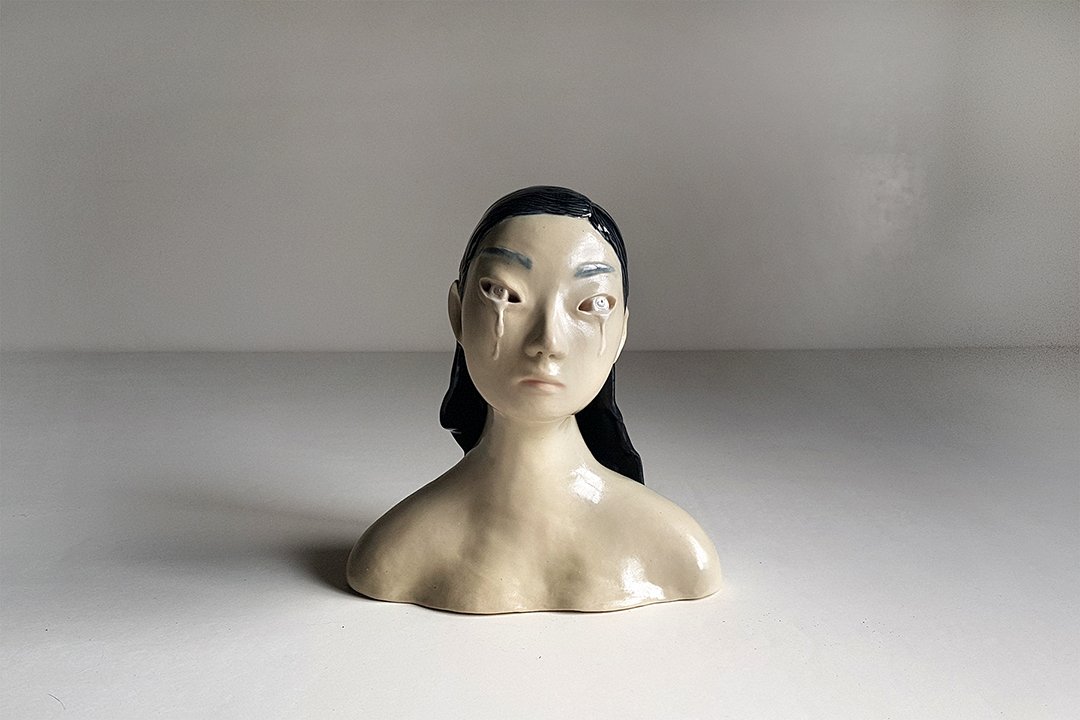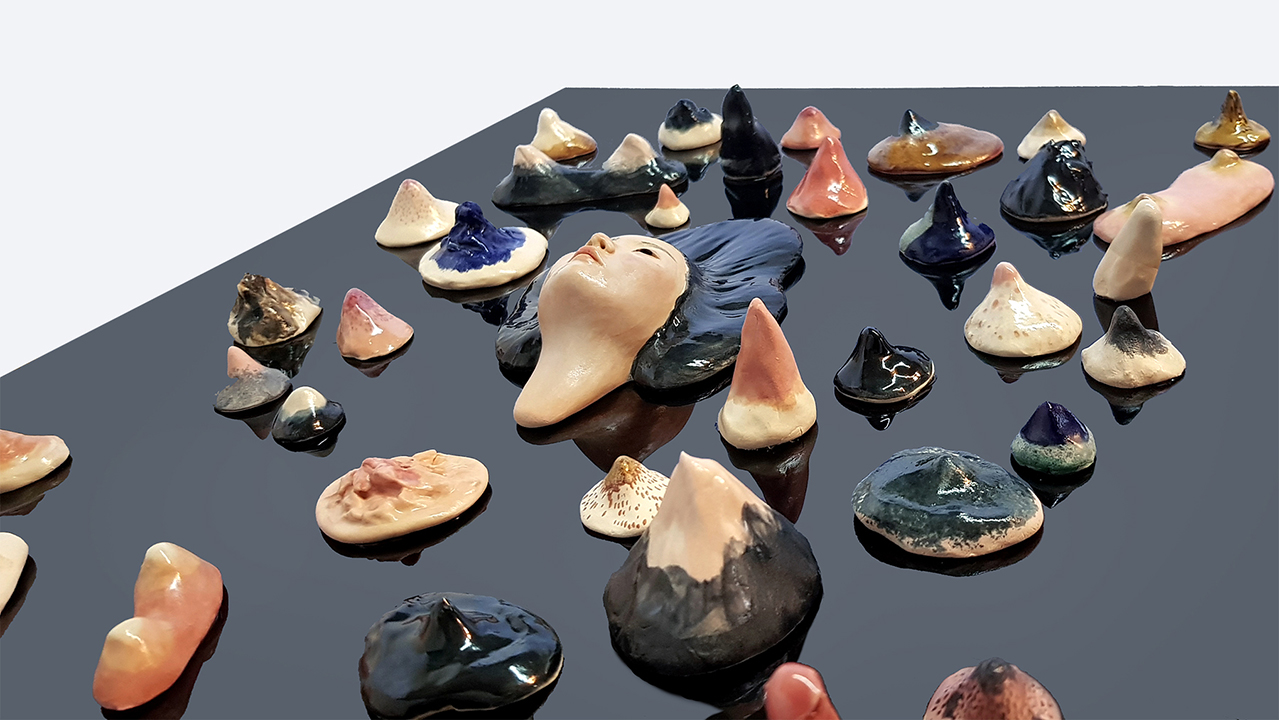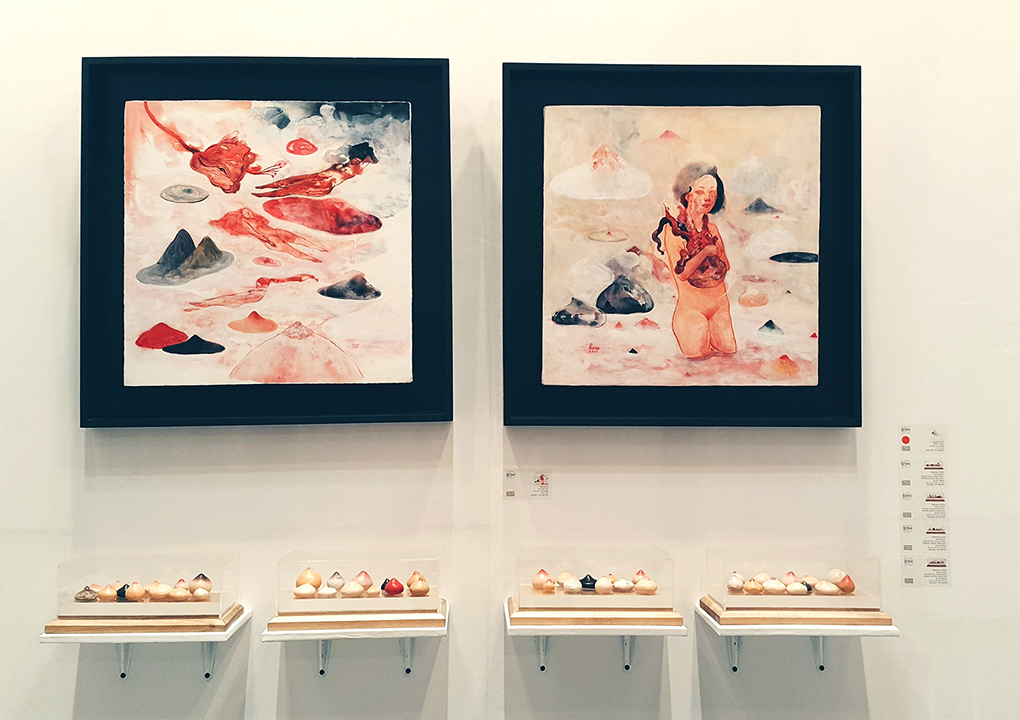Kara de Dios
Meet Filipino painter and sculptor, Kara de Dios.

Tell us a little bit about yourself.
I am a painter and sculptor. I’m interested in the feminine, body horror, the absurd, biologies in their micro and macro perspectives, slowness, and repetition as meditation.
I enjoy cooking & eating, practising yoga, avoiding traffic and escaping reality by watching TV shows at home and loving on my three cats. I live and work in our little house/studio with my partner, Rom Villaseran.
Describe the city you’re living in and what it’s like to live there.
For the past 30-ish years, I’ve been living in a city within Metro Manila called Marikina. It’s kind of sandwiched between two larger cities, Quezon City and Pasig. It’s not as wildly gentrified as its neighbours so it retains certain charms, such as walkability and sidewalks (rare in my country), and is small enough to manage to enforce good behaviours, like segregating trash (again, rare in my country). I appreciate that the city makes room for an environmental agenda because Marikina River runs through the city and floods nearby areas during typhoon season. In a place where open spaces are being swallowed by malls and condos, it feels good to still be surrounded by trees and to spot the occasional crow/maya/woodpecker in our area.
I’m interested in the feminine, body horror, the absurd, biologies in their micro and macro perspectives, slowness, and repetition as meditation.
What is the best and worst thing about living in your city?
The best thing is definitely the people. And the food. The worst thing is everything else, ha ha. But no, it’s fine. Like frog-in-boiling-water fine. With regards to art-making, accessibility to certain materials is difficult. Even some clays and chemicals need to be imported. However, the flip-side to that is people here are really some of the most creative, inspiring, and resourceful you’ll find. They work around and within this scarcity and the limited parameters set by this polluted, corrupt, traffic-choked, sometimes uncaring metropolis. Their ability to make something beautiful and thrive in such a setting is truly wonderful.
Give us 3 words that describe what it’s like to be a creative in your city.
Challenging, fun, expensive.
How did you start your career in art?
I’d have to say it’s been a bumpy ride down this path. I’ve been drawing since I was a kid and was dubbed an artist by my family so that’s been an identity I don’t know if I chose or was handed to me? Either way, I liked making stuff with my hands. In high school, I’d sell drawings to classmates and would be volunteered for poster-making contests (a great school-sanctioned way to skip classes for the day). I was art editor of our school paper as well, which was really just me inserting my personal drawings at the back of every issue.
For college, I originally started out in UP Architecture but about died, along with my grades, when calculus came around on the curriculum. I begged my parents to let me shift to Fine Arts. Miraculously, they agreed and I completed a BFA in Visual Communication. Those college years were the happiest, craziest, and most formative years of my life. It was here that I’d found my people and drawing didn’t seem so lonely anymore. We hung out in each others’ houses, drew and painted together, and mounted a bunch of exhibitions together. During this time, I dabbled in a lot of other things as well. I had some sort of informal graphic design practise (logos, book design, illustration). I had my portfolio reviewed for a children’s book illustrator job (the reviewer was not impressed with my tenderly rendered nudes). I held a 9-to-5 as a Flash animator for a Taiwanese cellphone greeting company. The internet came around and I taught myself HTML, CSS, and PHP, and would make blogs and websites for myself and friends.
Around a year after graduating, I got married to a wonderful guy. However, this new way of life marked a rough adjustment period that manifested in my career confusion. I had continued my graphic design business and took a web design job at a start-up company while painting and drawing on the side, as well as learning to live with a partner for the first time and manage a household.
During this period, I became increasingly disillusioned with being an artist and waffled about whether to pursue it or not. Grand proclamations would be made (“I quit art! From now on I’m only going to do [insert flavour of the next six months here]!”) and I’d completely devote myself, turn around and come back running to my paints and brushes. Flip it, reverse it, repeat ad nauseam. YEAH. This lasted about five years.
Eventually, I came to realise that the art world is big enough for everyone, even me. I quit all web and graphic design jobs, grew up and calmed my tits enough to carve out a little career of being a full-time Real Exhibiting Artist around 2014. I also became interested in ceramics and taught myself to sculpt around 4 years ago. I want to add how lucky I was to have a partner who patiently supported and indulged me during this truly weird time which gave me the luxury to experiment until I found my voice.
Were the people around you supportive of your decision on working as a creative?
Luckily, very much so. My father is actually a good artist himself, and both my folks come from creative families that, understandably, did not pursue music or art as careers. They are both economists who come from a line of teachers and academics. Growing up, they instilled in me an appreciation for art, history & culture so I guess I can’t be entirely blamed for ending up in a career in art-making. Though I’m sure my parents wanted me to have a “safer” career, they’re happy seeing me where I am now.
What are some goals and ambitions you have for your future work?
I want to create a huge assemblage of small sculptures. For now, I still consider myself a beginner in sculpture and am enjoying this experimentation stage. I would also love to teach one day when I’m better at my craft.
I want to create a huge assemblage of small sculptures. For now, I still consider myself a beginner in sculpture and am enjoying this experimentation stage. I would also love to teach one day when I’m better at my craft.
If you could collaborate with any person in the world who would it be?
My mind says an environmental conservation group or provincial museum, my heart says Alaska Thunderf*ck.
How would you describe the women around you?
Strong. Unflappable. Opinionated.
Were there any local female creatives that you looked up to when you were growing up?
I must’ve been 12 or 13 when my parents took me to an exhibition with this work by Agnes Arellano. My little brain exploded. I had seen figurative classical sculptures in Europe as a younger kid but here I was seeing one in my own backyard. Finding out the artist was female was even more powerful. It’s like it told me, “See, you can do it too!” I named my kiln Agnes after her because I admire her work so much.
I also love Elaine Navas but only put her name to her work a few years ago. Her paintings depict mundane things made magical through her glorious brushwork. She is amazing!
Are there any challenging aspects of being a female in your industry?
I would say there is an invisible pressure to market yourself alongside your work, but that’s probably true for any industry where personality/persona plays a part in the end-product. It’s challenging for me because I consider myself a shut-in who hates going out, ha ha. Other than that, the industry seems quite open to everybody.
Invaluable advice I learned from my partner: Hold regular studio hours. Being your own boss is hard so having a routine helps tons. Even when you don’t feel like working, make sure you stay in the studio. You can read a book or stare at old work.
Do you have any advice to young women who are aspiring to work in your field?
1. Invaluable advice I learned from my partner: Hold regular studio hours. Being your own boss is hard so having a routine helps tons. Even when you don’t feel like working, make sure you stay in the studio. You can read a book or stare at old work.
2. Be kind to your body, especially your hands, wrists, and eyes.
3. You are not a machine! Take a break if you feel you need it.
4. Failure is essential.
5. Experiment and play. Don’t lose your sense of wonder with your materials.
6. Enjoy!
Photos courtesy of Kara de Dios
Website:
Instagram:
Category:
PhilippinesDate:
November 20, 2019














